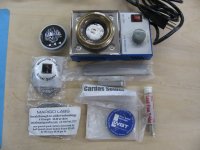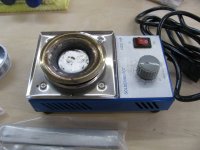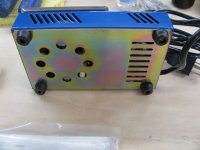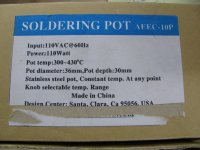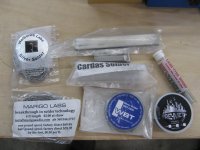I recently made a fascinating accidental discovery: By choosing unconventional crossover frequencies and baffle dimensions, you can achieve Constant Directivity using regular woofers and dome tweeters - without waveguides, horns or dipoles.
I call it Zero Horn Constant Directivity (ZHCD). Jack Regula (
@nc535) ran some simulations and helped me refine the model. First I’ll show off the end result, then I’ll explain the theory and model and give you a design guide.
Example #1: 5” 2 way with dome tweeter. Focal 5N402DB 5" woofer + Audax TW025 25mm dome. Front baffle is 8" wide.
First I tried a 1700Hz crossover which got me this frequency response at 0, 15, 30, 45, 60, 75, 90 degrees off axis:
Notice some "bunching" around 2500Hz. This bunching comes entirely from the tweeter, as the crossover is 1700. At 45 degrees off axis, the output is +4dB higher than on axis.
BUT guess what… if I set the crossover at 4900Hz I get this:
Theory (what I
thought I knew about tweeter dispersion = omnidirectional below 8KHz) said this was impossible. Simple theory would predict the woofer is directional above 1K while the tweeter is not directional until 8-10K, but as you can see here, the tweeter’s directional characteristic matches the woofer’s almost exactly.
I might have just thought it was odd and shrugged my shoulders and went on, but I noticed the same thing with another smaller system – A JVC HSA1014 + Dayton ND16FA. Cabinet is 4.5” wide and 6.5” tall.
I attempted a 3KHz crossover and got similar results as my first try above (bunching around 4KHz), but then a 7KHz crossover got me this result:
This is an almost perfect Constant Directivity result above 1KHz with considerable directionality from a tiny 16mm tweeter… which I would expect to have NO directionality!
This was a big surprise. So I got curious. This reminded me of a phenomenon that I observed with the
Live Edge Dipoles, which have a wide 19” live edge wood baffle and an 8” coaxial mid-tweeter. The Live Edge Dipoles have a minor but noticeable “bulge” at +/-45 degrees off axis, at about 1KHz:
On the low end, Dipoles start rolling off at λ = 2X cabinet width, and normal box speakers similarly have a -6dB Baffle Step at λ = 2X cabinet width. Lots of speaker designers know about these.
Now there are a couple of other baffle diffraction modes I don’t recall getting much attention. If you know what you’re doing, you can really take advantage of this and achieve Constant Directivity without horns or waveguides.
It turns out this +/-45 degree bulge at 1KHz in a 19” wide baffle corresponds to the 2.5KHz bulge from the 8” wide baffle, which also corresponds to the 4KHz bulge from the 4.5” wide baffle. I call this
Baffle Bulge. It occurs across a range of λ = 0.5X to 1X cabinet width. At this frequency the on-axis response is the “normal” and “expected” but the off-axis response has a peak caused by diffraction from the edges of the baffle.
Then at even higher frequencies, where λ = 0.25X to 0.5X cabinet width, you get a
Baffle Beam and over this octave, on-axis radiation is strong; but off axis drops off much like if you had a waveguide.
So if I draw these points on the polar plot above, it looks like this:
So this means in the 5” 2-way with 8” wide cabinet, most people would cross the tweeter at 2-3KHz fearing that the woofer will get too beamy, and has too much cone breakup. That’s what I did in my first attempt. But what I found was: Even the small 5” woofer begins to beam above 1K and then the tweeter has +4dB lobes at +/-45 degrees at 2.5KHz and the off axis response is very uneven.
Yet if I cross it over at 5K, the woofer’s natural beaming has already kicked in and is not as bad as I feared; also,
the woofer’s beaming is not affected much by the front baffle dimensions; and then the tweeter is benefiting from
Baffle Beam from 4KHz to 8KHz; and above 8KHz the 1” dome begins beaming naturally because of its dimensions; and viola, I get Constant Directivity behavior from 500Hz up. The combination of woofer beaming and calculated cabinet diffraction gets us almost identical polar patterns and CD behavior from woofer and tweeter alike.
Again:
In the 4.5” 2-way with 4.5” wide cabinet, the woofer’s beaming from 3-7K is matched by the tweeter’s Baffle Beam above 7K and even this tiny system gives me Constant Directivity behavior from 1000Hz up:
I’ve been designing speakers for a long time, so I’m conditioned to avoid woofer beaming and breakup and handoff to the tweeter at a low frequency. But it turns out if your woofer has well behaved gradual breakup modes at the upper end of its range,
and you design the crossover appropriately (the woofer crossover on both of these was more complex than usual), you get the fantastic imaging that CD designs are known for and both of these systems are well behaved at the upper end of the woofer’s range.
So I asked Jack Regula (
@nc535 ) to run some simulations to shed light on this. All of these simulations are of a 1” tweeter only (there is no woofer in the simulation) mounted on a box of dimensions 8” wide x 13” tall.
So let me step you through the research Jack and I did. First, Jack experimented with rounded vs sharp edges, and found that an 18mm bevel on each edge greatly reduced high frequency ripple. So all the simulations that follow assume that 18mm bevel.
Secondly, asymmetry in diffraction is also desirable. The worst situation is a tweeter in the middle of a round baffle. Second worst is putting it in the middle of a square baffle. Third worst is putting it in the middle (as I admittedly did in my small 2-ways).
When Jack put the tweeter in the center of the baffle, this is the polar heat map he got:
Notice significant “Baffle Bulge” at 2.5-4KHz which we are avoiding by choosing a 5KHz crossover.
Jack moved it off center and found a really nice spot here. The red dot is the tweeter location:
At this off-center position, Baffle Beam is working for us from 4-8K and has no nasty peaks or surprises:
[Please note that Jack’s models have irregularities above 8K that are a result of not using tons of points in the calculations, to save computer time – artifacts of the simulation.]
